Hawaii’s Clean Energy Options; Today
Chapter One – what happened …
Recently, residents and businesses of Oahu and Hawaii Island were advised of an all too familiar public message “…customers are asked to reduce electricity use.“
Just last week local news outlets led with this story and requested of Hawaii Island residents…“Hawaiian Electric is asking residential and business customers on Hawai‘i Island to reduce their electricity use tonight, especially from 5 p.m. to 9 p.m. when electricity use is highest. The conservation of power will help ensure that there is enough power available for all customers.”
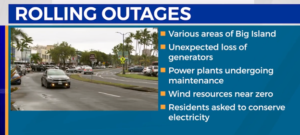 The Utility’s request for energy conservation was prompted by the failure of more than one of its large (so-called firm energy) combustion power plants. Two other combustion power plants were also shut for maintenance demonstrating the fragile of house of cards of the state’s energy grid. It was also what became the perfect storm in a chain of gird operating events concluding in a power supply emergency, and forcing the utility into a series of rolling customer power blackouts in an effort to prevent a system-wide power failure.
The Utility’s request for energy conservation was prompted by the failure of more than one of its large (so-called firm energy) combustion power plants. Two other combustion power plants were also shut for maintenance demonstrating the fragile of house of cards of the state’s energy grid. It was also what became the perfect storm in a chain of gird operating events concluding in a power supply emergency, and forcing the utility into a series of rolling customer power blackouts in an effort to prevent a system-wide power failure.
Hawaii Island’s 17,000 rooftop solar residents and businesses, and utility customers with whole house battery back-up were unaffected and remained power self-sufficient during the declared power emergency. These same utility customers were also fully protected from the utility’s planned rolling power outages, which also come with notorious property-damaging power surges impacting appliances, computers, and other plugged-in high-value electronics.
HELCO’s power problems began when independent power producer Hamakua Energy (a hybrid fueled combustion power plant consisting of 90% tar sands oil and 10% bio-fuel mix) unexpectedly tripped offline late in the afternoon.
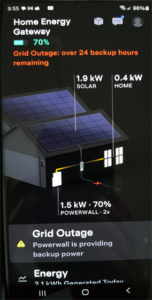 HELCO’s remaining combustion power plants on which the utility relies, were either shut for repeated maintenance and repair cycles. In the case of the state’s only geothermal power plant, Puna Geothermal Venture on Hawaii Island, the plant has been operating at reduced power production capacity, and well below its power production commitment to HELCO, and in its reduced operating state unable to close the power gap. This has been a recurring theme for PGV operations since the 2018 eruption of Kilauea which fully disrupted geothermal operations for more than 2 years. It further demonstrates in this most recent power failure event PGV’s inability to perform as contracted, and supports what local critics of the plant have been saying all along … it is a community environmental hazard, expensive to operate, and unreliable in its capacity as a so-called firm power plant.
HELCO’s remaining combustion power plants on which the utility relies, were either shut for repeated maintenance and repair cycles. In the case of the state’s only geothermal power plant, Puna Geothermal Venture on Hawaii Island, the plant has been operating at reduced power production capacity, and well below its power production commitment to HELCO, and in its reduced operating state unable to close the power gap. This has been a recurring theme for PGV operations since the 2018 eruption of Kilauea which fully disrupted geothermal operations for more than 2 years. It further demonstrates in this most recent power failure event PGV’s inability to perform as contracted, and supports what local critics of the plant have been saying all along … it is a community environmental hazard, expensive to operate, and unreliable in its capacity as a so-called firm power plant.
In addition to Hamakua service disruption and PGV’s power capacity issues, Hawaiian Electric’s Hill Plant Unit No. 5, Keahole CT-5, and separately, Puna Steam Plant were shut down and unavailable for scheduled maintenance and repairs (high maintenance for combustion power plants with their many system components and moving parts is indicative of the technology required to maintain 24×7 firm power combustion plant operations).
The only grid-scale solar power plant plus storage on Hawaii Island, the AES Waikoloa Solar + Storage Plant which began commercial operations in April 2023, mitigated the impacts of utility’s overall system operating failures and production shortfalls. The Solar plant is the largest project of its kind on Hawaii Island, with a 30 MW solar photovoltaic system and a 120 MWh containerized lithium-ion battery energy storage system. Just this one Solar plant addition to the grid is expected to lower residential monthly utility bills by about $5.
The project is located on 300 acres along Waikoloa Road and is supported by a 25-year Power Purchase Agreement (PPA) with Hawaiian Electric, providing power to nearly 14,000 homes. The plant is designed to reduce visual impacts, has undergone cultural and archaeological assessments, and includes safety measures such as fire suppression systems and non-vegetated firebreaks. The project has been well received by the community and is a shining example of how Hawaii can achieve it’s 100% (clean) renewable energy goal before 2045.
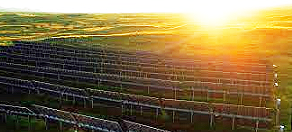 Altogether, the solar plant propped-up the utility’s combustion plant-generated power shortfalls and a system wide service outage. Solar energy+storage at utility scale, coupled to customer sited distributed rooftop solar assets prevented a bad power situation from getting much worse. Extra credit was due island residents who curtailed their power consumption during the grid operating shortfall. Hawaiian Electric and ratepayers were lucky in contrast to what could have easily been a much worse and extended loss of service across the entire Island, and a greater service outage impact on residents and the economy.
Altogether, the solar plant propped-up the utility’s combustion plant-generated power shortfalls and a system wide service outage. Solar energy+storage at utility scale, coupled to customer sited distributed rooftop solar assets prevented a bad power situation from getting much worse. Extra credit was due island residents who curtailed their power consumption during the grid operating shortfall. Hawaiian Electric and ratepayers were lucky in contrast to what could have easily been a much worse and extended loss of service across the entire Island, and a greater service outage impact on residents and the economy.
Chapter Two – it all adds up
Fuel / Maintenance Costs, Operating Reliability, and Sustainability
The U.S. Energy Information Administration which provides data on the operations and maintenance (O&M) costs for different types of power generation found that large-scale solar photovoltaic (PV) installations with/without battery storage are among the cheapest and most reliable power generation technologies to operate. According to the energy agency, a comparison of costs between solar power and combustion fossil and biofuels plants favors solar power installations, which have repeatedly demonstrated lower operating costs and minimal operating and maintenance (O&M) requirements, altogether supporting greater cost efficiency outcomes to the benefit of utility profits and ratepayer energy costs…
Beyond, periodic cleaning and inspection, solar energy power plants are truly the O&M low-cost energy winner. In contrast, combustion power plants burn various fuels to create heat towards converting water into steam, which in turn spins large turbines to generate electricity — altogether is an electricity generation process that inherently results in higher operating costs and added fuel costs measured in combustion plant maintenance and operating costs. Solar, and even Wind Power turbines, are simply cheaper to operate and offer greater power generation reliability when executed properly over the lifetime of their investment – a missing element of ratepayer consideration in Hawaiian Electric’s weak adoption record to date of solar and wind assets and clean power into their grid energy mix.
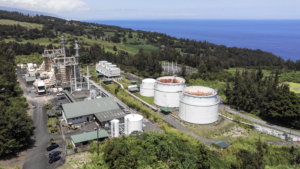 In a comparison of costs between solar and wind power vs. combustion power plants, solar and wind power installations can further credit their overall lower lifetime operating costs to their base fuels; sunlight and wind. These two natural energy zero-cost and zero-emissions fuel sources, although variable, do not have supply chain issues. In contrast, fossil fuel and biofuel power plants which not only have higher maintenance costs, are subject to the variables of continuous purchases of fuel-to-burn from suppliers, which are further subject to market supply variables and price fluctuations that contribute to higher energy costs borne by ratepayers, not utilities.
In a comparison of costs between solar and wind power vs. combustion power plants, solar and wind power installations can further credit their overall lower lifetime operating costs to their base fuels; sunlight and wind. These two natural energy zero-cost and zero-emissions fuel sources, although variable, do not have supply chain issues. In contrast, fossil fuel and biofuel power plants which not only have higher maintenance costs, are subject to the variables of continuous purchases of fuel-to-burn from suppliers, which are further subject to market supply variables and price fluctuations that contribute to higher energy costs borne by ratepayers, not utilities.
Added fuel costs and supply risks are associated with HE’s dirty energy combustion power plants, favored by the utility. From a utility’s perspective, maintenance cost comparisons between combustion power plants and solar power plants are secondary financial considerations when costs and risks are fully assumed by ratepayers. Yet, both are important considerations in the choice of appropriate energy supply options available today.
Utilities often fail to fully factor all aspects of the energy source choices they make. Front and center is the plant’s return-on-investment (ROI) when utility the plant is utility owned and operated. Operating reliability considerations are generally relegated to a grid operators’ preference, in the case Hawaiian Electric, with issues as to the plant’s technology and operator (when third-party owned and operated), as secondary considers that rarely serve the public interest. Altogether, important grid energy supply decisions represent the vested interests of the utility’s customer base ( ratepayers), but are rarely challenge assumptions by the public who generally trust the utility operate in their best interest. Yet, within this one-sided relationship between utility and ratepayer, lessons repeatedly learned, are quickly and forgotten. A call for significant changes in the present process of governing energy choices made by the regulated utility fail public scrutiny, gnerally after the fact, as recent events service outages on both Hawaii Island and Oahu have demonstrated.
Fully automated Solar plus Power Plant (Kauai)
Clean energy with power battery power provisioning at scale; no moving parts, low cost, high reliability of operation
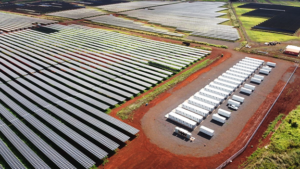
Combustion Power Plant example (Hawaii Island)
Maintenance-intensive, fuel burning reliant, less reliable, costly to operate, and polluting
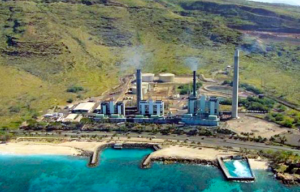
Chapter Three – a power play
How the Power Playing Field is Changing
Hawaii’s utility lexicon is ripe with insider terms system like “baseload” and “firm power”. The latter is frequently used the Utility’s political agents as a weapon against solar and other under-deployed clean power options within the state (except in Kauai) to justify the status quo energy path we’re on and explain Hawaiian Electric’s (HE) power plant choices 9 times out of ten favoring combustion power plants. It is a future energy outlook in which state could burn its way off fossil fuels an onto other dirty fuel options associated with the state’s HE-dependent combustion power plants, both utility-owned and outsourced.
Most of Hawaii’s residents and state economy depend on HE’s combustion power choices and are expected to assume their electricity options are dictated by their utility and operate in their best interest. It is worth remembering that publicly-traded utilities, as is the case with HE are first and foremost responsible to their shareholders, and ratepayers (customers) are merely funding their operating profits.
However, ratepayers, which includes most state politicians, along with the state PUC do have options in directing the utility’s energy choices. Today’s combustion power plants are neither sustainable nor cost and energy-effective power options, they are merely easier low-risk, and utility-invested power options that come at a high cost to ratepayers who foot the bill, and to Hawaii’s residents who pay the price in pollution and unsustainable energy combustion outcomes at a time when our planet is undergoing a growing climate crisis.
Hawaiian Electric’s Baseload Utility Grid Power Model: Outdated, Costly, Less Reliable, and …Unsustainable
The 20th-century “Baseload” utility power model is increasingly costly, inefficient, and certainly out-of-step with 21st-century power demands and clean power technology replacements. Coupled with advances within the areas of energy storage, rooftop solar and utility-scale solar and wind resources coupled with battery storage technology are increasingly supporting grid scale 24×7 customer energy demands, with or without expensive last-century combustion power plants.
In the case of the state’s largest utility, Hawaiian Electric, it has been and remains stuck on a power provisioning strategy dominated by last-century utility operating assumptions, and primarily supported by combustion power plants burning various fuels around the clock to maintain a stable state of power output to the grid, aka baseload power. It is also possible the most expensive power generation and operating practice within the state – one that is indifferent to customer self-generation energy opportunities and an overall market transition to a more distributed and resilient grid power provisioning architecture, one that further and further away from centralized 20th century grid power model, long-hauling power over great distances between the point of power generation, and the end point of consumption. It is a utility operating model that is increasing expensive to maintain, and increasingly unstable to operate in light of accelerating climate consequences worldwide.
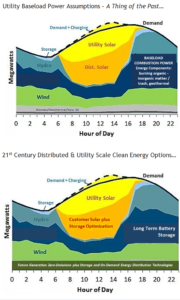
Today’s electricity grid system is highly reliant on so-called “baseload” power plants. The combustion energy resources they represent are increasingly out of step with today’s lower cost, clean renewable energy technology options, and distributed energy options which enable power to be generated at or near the power of consumption instead of long-hauling power of a fragile and expensive grid system. In terms of operating reliability, Hawaiian Electric’s baseload energy supply models and partners are increasingly demonstrating more, not less, cost increases and unreliability in a changing world — and who pays the bills; utility ratepayers.
The price competition from zero emissions clean and 100% renewable energy combined with 21st-century energy storage options and natural gas is far stronger than it was in the past, meaning that it no longer makes sense to default to inflexible baseload power plants, which are enabled adjust and load-balance instantly ramp up and down, to serve variations in power demand. Instead, as many already are doing, regulatory and other decision-makers should focus on a framework that:
(a) effectively and efficiently defines a electricity system linked public needs and in compliance with clean energy policies designed to advance operational flexibility, resilience, greenhouse gas abatement, and last but certainly not least, lowering energy costs for consumers ), and secondly,
(b) develop tools, markets, and methodologies that draw upon an increasing range of available distributed zero emissions energy generation and storage options applied towards Hawaii’s unique service geography, as in self-reliant and stand-alone community microgrids linked together to rooftop solar systems and other localized clean energy power systems — it is complete transition to distributed statewide power system no longer dependent on a last century grid energy assumption and obsolete power generation and energy management assumptions presently governing the state’s largest utility.
Chapter Four – full of better options
Clean Power Community Microgrids; Resilient and Self-Sufficient
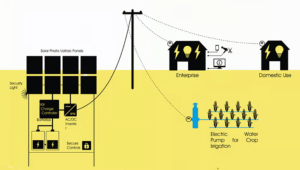 Granted, there may never come a day when every qualified building rooftop in Hawaii will have solar installed and on-site batteries providing energy management security and efficiencies without the need for a centralized power monopoly. However, Hawaii’s abundant natural and non-polluting solar and wind energy sources (when appropriately applied) are by far proven to be the most cost and energy efficient options available today.
Granted, there may never come a day when every qualified building rooftop in Hawaii will have solar installed and on-site batteries providing energy management security and efficiencies without the need for a centralized power monopoly. However, Hawaii’s abundant natural and non-polluting solar and wind energy sources (when appropriately applied) are by far proven to be the most cost and energy efficient options available today.
Clean energy technology options which are available today with unprecedented consumer power visibility, flexibility, and management options. At the utility demand scale, battery storage offers on-demand power provisioning from wind sources (when the wind is not blowing) and solar energy at night with the ability to ramp up or down quickly to meet changing demands – eliminating the so-called need for grid-based and wasteful Baseload power production.
Community Microgrids further enable power resiliency by generating power at and near where power is consumed, rather wastefully long hauling to the point of consumption some distance away from where it is generated. Microgrids manage and distribute power locally, offering greater power efficiency, providing power flexibility not otherwise possible, improve cost performance and power resiliency for all concerned.
Additionally, markets (including Hawaii) can and will eventually embrace the value of state-mandated energy policy options which advance today’s wind and solar power deployment options coupled to battery storage (scaled to firm power standards) — something HE has yet to demonstrate throughout its service territory, and certainly so not at scale to meet the state’s growing power transition requirements off fossil fuels and to greater power self-sufficiency throughout the state. Between policy, will, and profit motivates out of synch with the greater good, Hawaii Electric continues to stand in stark contrast Kauai Island’s clean energy leadership and business model.
editor P.S.
The Civil Beat reported earlier today (2-20-24) of a legislature-driven statewide taxpayer & ratepayer funded bailout of Hawaii Electric Co, ow in the works. CB reported that Lawmakers are calling for significant changes at Hawaiian Electric Co. in exchange for letting the utility charge a new fee to customers to raise money to deal with wildfire costs. The fundamental change sought by HECO would allow the company to impose new fees on its 460,000 customers statewide outside the standard ratemaking process. The utility could use the fees to finance bonds at a lower interest rate than it could otherwise obtain.
HECO faces substantial liabilities related to the Maui wildfires, which destroyed much of Lahaina and killed at least 101 people last August. As a result, shares of parent company Hawaiian Electric Industries have plummeted, and credit rating agencies have downgraded the company’s to a junk bond rating, which in turn costs the utility more to borrow as it seeks to deal with rising wildfire costs and its fire-related operating liabilities.
Sen. Jarrett Keohokalole, the legislative driver of a utility bailout said in an interview today. “Put simply, what’s being proposed is a fundamental change to the dynamic between the state and the utility. And so the question is…, What type of fundamental change should be made in return?”
Our advice Sen Keoohaloke, read this article!




Leave a Reply
Join the Community discussion now - your email address will not be published, remains secure and confidential. Mahalo.